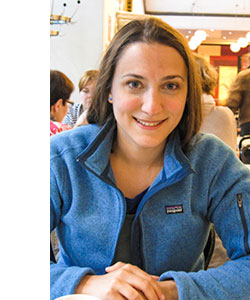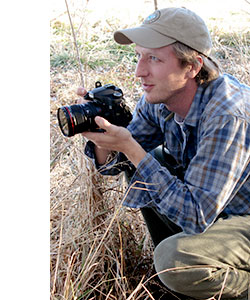Brandice Gonzalez-Guerra, Department of Art

Where are you originally from?
I was raised in Chicago and Skokie, Illinois.
Where did you complete your education?
I received my undergraduate degree from The School of the Art Institute of Chicago and my graduate degree from The University of Illinois at Urbana-Champaign.
Where have you taught prior to coming to HSU?
I taught at the University of Illinois during graduate school. I then taught at Illinois State University before moving on to a position as Director of the Studio Art Program at Northwestern Oklahoma State University. I was at NWOSU for two years before coming here.
What are your specific areas of expertise?
I produce images in both digital and traditional media. I am currently at work on a series of small scale paintings informed by my interests in natural history, scientific illustration, cabinets of curiosity, and 17th-19th century animal painting. I also recently worked on digital illustrations for an iOS game that is due for release later on this year.
What classes are you teaching this year?
I am currently teaching Beginning and Intermediate Drawing. In the spring of this year, I will teach two drawing courses and Illustration I.
What attracted you to Humboldt State?
I’m a natural history geek. I grew up reading National Geographic and had knowledge of this region through that magazine. I was camping in the Northwoods of Wisconsin when I saw the ad for my current position. The chance to live in the Redwood Forest and teach engaged undergraduates in an established university art department was too good to pass up! I applied and was thrilled to be interviewed. I really appreciated the friendliness, sincerity, and genuine support for the arts that is present in this place.
What do you do in your free time outside the classroom?
I really don’t have much free time right now, but when I do, I like to walk my dog in the forest, read books outside of my discipline, watch science fiction movies, and play video games. This coming summer, I’d like to get into fishing and kayaking.
What is your favorite classroom technique to engage students?
I like to try to incorporate a sense of playfulness into my lectures and demonstrations. Trying to learn new techniques, history, and professional language and developing new ideas within a nascent artistic practice can be daunting for students. It’s my hope that in using humor, my students feel as though they can enjoy the learning process in its entirety—both in momentary setbacks and in successes.
What is the best thing about being a university professor?
The best thing about being a professor is that I get to witness the moment when a student first fully comprehends a new idea. I get to see the that joy on a daily basis—very few other occupations allow you that sort of contact with another human being. It’s a really special thing to be able to share something you feel very passionately about. I know that I’m very lucky to have this job.
Where is the strangest place you’ve done research?
I don’t really do research in strange places, but I have been to some neat places to study. I think my favorite experience with primary documents was in the Newberry Library in Chicago. The library itself is housed in a wonderful Romanesque building made of pink granite that sparkles in the light as you approach it. I was there to look at William Morris Kelmscott Press books that were illustrated by Edward Burne-Jones. Being able to be in that grand space and touch objects that my art heroes touched was really thrilling.
If you weren’t an HSU professor, what would you be?
If I wasn’t an HSU art professor, I’d probably be a veterinarian at a teaching hospital. I’ve always had a keen interest in biology and veterinary medicine and worked at couple of vet clinics as a tech and a receptionist as a young adult. I respect and admire the work of veterinarians. I do love teaching and I think that had I gone that route, instead of this one, I would still be a teacher in some capacity.
What superpower would be most valuable to your research?
I don’t know if this is a superpower, but I wish I had the ability to be healthy and function well without ever needing to sleep. Those extra seven hours would be marvelously helpful in getting things done.
Daniel Barton, Department of Wildlife

Where are you originally from?
Chicago, Ill., but I have since lived or worked for long periods in Washington, Oregon, California, Alaska, Mexico, Venezuela, Hawaii and Montana.
Where did you complete your education?
I have a Bachelors of Science from the Evergreen State College in Olympia, Wash., and a Ph.D. in Organismal Biology and Ecology from the University of Montana in Missoula, Mont.
Where have you taught prior to coming to HSU?
I was a teaching assistant at the Evergreen State College and I taught as an adjunct at the University of Montana.
What are your specific areas of expertise?
First, and foremost, I am interested in natural history. Biology is an attempt to explain the patterns we observe in nature, and I use the conceptual frameworks of population ecology and evolutionary biology to attempt to explain patterns in population growth and differences among species in traits like life span and fecundity. This is an integrative area that has forced me to develop skills in statistics and applied mathematics that I really enjoy teaching simply because I’ve found them so valuable.
What classes are you teaching this year?
I am currently teaching Wildlife 478, the Ecology of Wildlife Populations, and Wildlife 510, Advanced Principles of Wildlife Management. These courses focus on understanding the process of population growth and how we take data from wildlife populations and turn it into useful information.
What attracted you to Humboldt State?
Humboldt State has a great wildlife program, and a great community in general, and I am just tickled I get to be a part of it. Also, I love California! I previously lived in California from 2000-2004 and I immediately felt at home.
What do you do in your free time outside the classroom?
I (try to) catch fish, go searching for wildlife, read, and write. I usually have a half-finished construction project laying around of some sort … currently it’s a boat.
What is your favorite classroom technique to engage students?
I think experiential learning is the most fun, and I also think that it is the most holistic way to engage students.
What is the best thing about being a university professor?
I had a great experience in my undergraduate and graduate education. I get the chance to try to pass along that experience and continue our strong tradition of public education.
Where is the strangest place you’ve done research?
I worked for four months for the U.S. Fish and Wildlife Service on Kasatochi Island, a small island in the Aleutians that was a collapsed caldera. The island more or less completely blew up in a volcano five years after I lived there.
If you weren’t an HSU professor, what would you be?
A wayward field biologist, chasing a bird on an island somewhere … I suppose if I wasn’t a scientist, I’d be working in social justice in some capacity.
What superpower would be most valuable to your research?
I would want the superpower of the world’s wildest and most unconstrained imagination. I think imagination is the most undervalued trait in scientists.
##